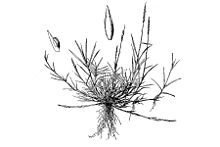- Zoysia matrella
-
Zoysia matrella 
Zoysia matrella line drawing[1] Scientific classification Kingdom: Plantae (unranked): Angiosperms (unranked): Monocots (unranked): Commelinids Order: Poales Family: Poaceae Subfamily: Chloridoideae Tribe: Cynodonteae Genus: Zoysia Species: Z. matrella Binomial name Zoysia matrella
(L.) Merr.Synonyms Zoysia matrella (L.) Merr., commonly known as Manila Grass, is a species of mat-forming, perennial grass native to temperate coastal southeastern Asia and northern Australasia, from southern Japan (Ryukyu Islands), Taiwan, and southern China (Guangdong, Hainan) south through Thailand, Indonesia, Malaysia and the Philippines to northern Australia (northeast Queensland), and west to the Cocos Islands in the eastern Indian Ocean.
Other common names include Korean grass, Manila templegrass, siglap grass (after an area in Singapore), temple grass, Mascarene grass, harishiba, hierba Manila (Spanish), Japanese carpet, jukut kakawatan hijau (Sundanese), rebha sekem-sekeman (Madurese), burikit (on Seram), rumput siglap (Malay), damong-alat, barit-baritan (Tagalog), malakuwerdas (Pangasinan), ya-nuannoi (Thai)[3].
Botanical synonyms include Agrostis matrella (basionym), Osterdamia matrella, Z. pungens, and Z. tenuifolia (now distinguished as Zoysia matrella var. pacifica)[4].
Two varieties are distinguished by some authors:
- Zoysia matrella var. matrella
- Zoysia matrella var. pacifica Goudswaard
Description
It forms extensive, velvety, green mats, spreading vigorously by stolons, or occasionally by rhizomes, once established. Z. matrella grows in low elevation preferring sandy soils where other grasses establish poorly. The stems are slender and prostrate, ranging from 5-25 cm in length. The leaves are alternate, produced at 1.5-3 cm intervals along the stem; they are slender, 2-10 cm long and 1-3 mm broad. The flowers are greenish, produced on erect racemes 6-35 mm long with a single 2-3.5 mm flower in each spikelet.
Cultivation and uses
Manila grass is grown as an ornamental grass, and is used for turf on golf courses in Asia, Europe and the Americas, as a lawn grass in the United States especially in the South, and is planted for grazing stock among the trees on tropical coconut plantations. In addition to its ability to grow on sandy soils, it tolerates high salinity, making it ideal for erosion control and lawns in coastal areas.
The variety of common names attests to its widespread occurrence in these regions along with its usefulness as a cultivated grass in diverse areas. It is naturalised in many places, as in Hawaii, and can become weedy, like many plant species with desirable horticultural characteristics.
References
- Online
- ^ Hitchcock, A.S. (2006). "USDA NRCS PLANTS Database". Manual of the grasses of the United States. http://plants.usda.gov/. Retrieved 2006-11-14.
- ^ Agrostis matrella L, the basionym of Zoysia matrella, was originally published and described in Mantissa Plantarum Altera. Generum editionis VI & specierum editionis II. Holmiae (Stockholm) 185. 1771 "Plant Name Details for Agrostis matrella". IPNI. http://www.ipni.org:80/ipni/idPlantNameSearch.do?id=325669-2. Retrieved May 23, 2011. "Malabar, India (Indian Subcontinent, Asia-Tropical)"
- ^ "FAO Grassland Species Profiles". http://www.fao.org/ag/AGP/AGPC/doc/Gbase/Default.htm. Retrieved 2006-11-14.
- ^ "USDA GRIN Taxonomy for Plants". http://www.ars-grin.gov/cgi-bin/npgs/html/tax_search.pl?Zoysia%20matrella. Retrieved 2006-11-14.
- General
- "Zoysia matrella (L.) Merr.". Australian Plant Name Index (APNI), IBIS database. Centre for Plant Biodiversity Research, Australian Government. http://www.anbg.gov.au/cgi-bin/apni?taxon_id=10523.
- World Grass Database: Zoysia matrella
- Pacific Island Ecosystems at Risk: Zoysia matrella
- USFS US Department of Agriculture Institute of Pacific Islands Forestry, Pacific Island Ecosystems at Risk (PIER), 2005. http://www.hear.org/Pier/index.html
Categories:- Zoysia
- Flora of Southeast Asia
- Flora of Malesia
- Plants described in 1771
- Garden plants of Asia
- Lawn grasses
Wikimedia Foundation. 2010.
